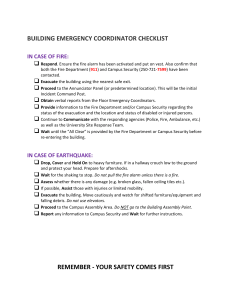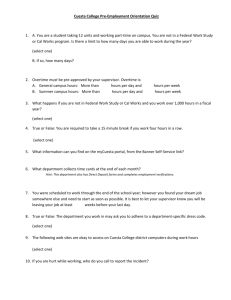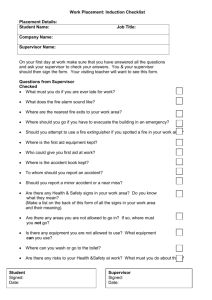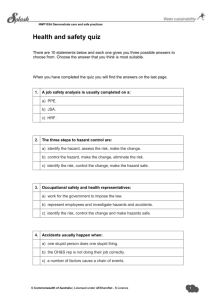Safety Lecture
advertisement
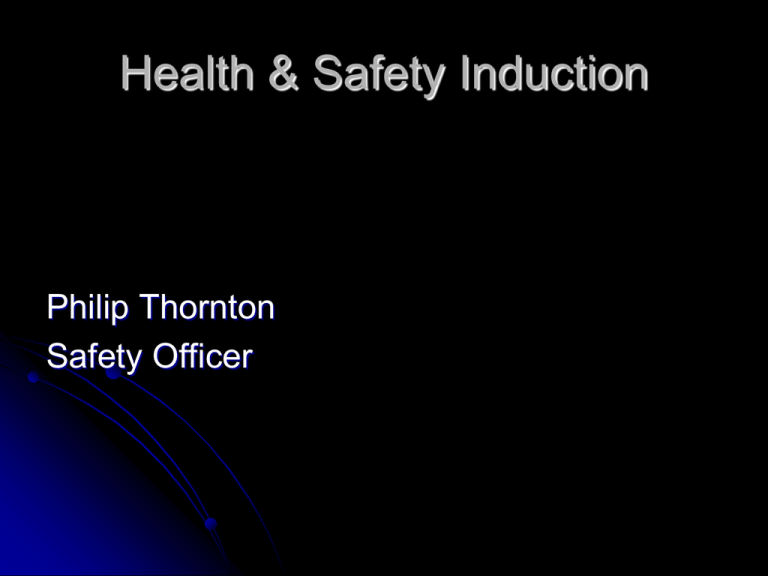
Health & Safety Induction Philip Thornton Safety Officer Introduction Today’s induction session will cover: Safety introduction Risk Assessments Fire Safety Accidents, Dangerous Occurrences & First Aid Display Screen Equipment Safety Training Working with Children & Young People Employee Support Service Safety Introduction Why safety is important? Legal requirement Expensive compensation claims Criminal prosecutions or other enforcement action by Health & Safety Authority (or Gardai). The incalculable cost of human suffering, much of which is so easily preventable. Safety Introduction Health and Safety… and YOU! • Take reasonable care of your own safety and anyone affected by your actions • Alcohol or drugs • Co-operate with the University on H&S issues • Improper conduct or behaviour • Attend required training courses. • Report defects or safety contraventions (to your manager) Safety Introduction Safety Representatives Committee Membership Human Resources Director (Chair) Dean, Faculty of Science & Engineering Nominee Safety Representatives (x 9) Buildings & Estates Services Manager Safety Officer Risk Assessments “A planned process during which hazards are identified and the extent of the risks involved are evaluated, taking into account existing precautions and their effectiveness”. “Hazard” – something with the potential to cause harm “Risk” – a combination of the likelihood and potential severity of harm from a hazard being realised All activities taking place on campus must be risk assessed and the risks reduced to an acceptable level, by means other than personal protective equipment where possible. Risk Assessments You / Your Departments must: Identify hazards Decide who is at risk Assess risks Prioritise objectives Eliminate or control risks (Risk Assessments must be in writing) Fire – Schuman, Feb 2011 Fire – MSSI, Feb 2010 If you discover a fire: 1.Raise the alarm by breaking the nearest fire alarm call point. 2.Call the Campus Emergency Number 061 213333 (put it in your mobile) or the Fire Brigade using the 999 or 112 system. 3.Do not tackle the fire and do not take risks. 4.Evacuate. If the fire alarm sounds: 1. Leave the building by the nearest exit point and don’t delay to pick up personal belongings. 2. Do not use lifts. 3. Assemble at the Assembly Point for the building. 4. Follow the Fire Stewards instructions and Do Not re-enter the building unless authorised. Familiarise yourself with the location of: the Fire Exits the Fire Alarm Call Point(s) the Assembly Points Main Accident Triggers Main Accident Triggers 1st Jan-31st Dec 14 13 Slips/Trips/Falls Burns/Cuts Road Traffic Accidents 2 30 2 Harmful Substances Physical activity 2 Manual Handling Miscellaneous 5 5 Accidents & Incidents All accidents and incidents must be reported as soon as possible Report them to your supervisor or manager. Your supervisor or manager should complete the Accident Report Form or Dangerous Occurrence Form First Aid If you require first aid assistance or come across somebody who does: Call Ext. 3333 or 061 213333 For more serious health events call an ambulance: 999 or 112 Display Screen Equipment Employees who will be using display screen equipment, such as a PC, as a routine part of their work activities should contact their Supervisor to arrange for an assessment of their work station to be carried out. To improve access to training in display screen equipment, an online training and risk assessment programme that can be completed by you at your workstation has been introduced. The e-learning software may be accessed by clicking https://limerickac.britsafelearning.com/login/index.php Safety Training Total No’s Trained (H&S) 1st Jan-31st Dec 2014 AED 8 19 First Aid Liquid Nitrogen 22 Gas Safety Awareness 3 15 6 Manual Handling Evacuation chair 4 130 Forklift 2 10 Work at Height Hazard ID + RA Chem Haz ID + RA 21 Child Protection Office Safety + Ergonomics 29 21 Fire Warden Fire Fighting 13 16 Pesticide Application Safety Signs Across the campus look out for H&S information signs Blue = Compulsory Failure to comply not only puts you at risk, but means that you have =broken the law BLUE Compulsory Failure to comply not only puts you at risk, but means you’ve broken the law. Yellow = Warning YELLOW = Warning Failure to take notice could put you at risk. Green = Safe guidance First Aid / Emergency Exits / etc GREEN = Safety guidance First Aid, Emergency Exits… Red = Prohibitive or Fire RED = Prohibitive or Fire Welfare of Children & Young People The University adopts the highest possible standards to protect children for whom it has responsibility. UL Child Protection Guidelines and the UL Garda Vetting Policy may be downloaded from the University website. Employee Support Service (ESS) The ESS is a confidential counselling and advice service to assist all of us in dealing with personal issues that could pose a risk to our health, wellbeing, relationships and jobs. Service is free to UL staff Service is voluntary – the decision to use the service and avail of counselling rests with the individual. The service is confidential and independent. FREEPHONE: 1800 201 346 Sensible Safety Drive slowly – the campus speed limit is 40 km/h (25 mph) Make sure you and your bicycle are readily visible (night & day) Take care at pedestrian crossings. Walk facing the traffic and keep to well-lit roads and pavements No smoking on the premises – please stay clear of doors, windows and air intakes. The use of e-cigarettes is also forbidden within buildings. Safety information available to you from: University Safety Statement Local Safety Statements and other Departmental sources Heath & Safety Essentials Booklet HR Website: http://ul.ie/hr/health-safetyul Welcome to UL and please contact me if you have any questions. Philip Thornton Ext: 2239

